Logistics and Supply Chain Management in Melbourne Airport Industry
VerifiedAdded on 2023/06/04
|22
|4474
|107
AI Summary
This study highlights the importance of logistic industry in case of handling the emerging challenges in Melbourne Airport industry due to increasing number of passengers. It sheds light on the current operational challenges and develops effective operational initiatives with proper impact discuss so that the entire business process can get benefited.
Contribute Materials
Your contribution can guide someone’s learning journey. Share your
documents today.

Running head: LOGISTICS AND SUPPLY CHAIN MANAGEMENT
Logistics and Supply chain management in Airport industry in Melbourne
Name of the student
Name of the university
Author note
Logistics and Supply chain management in Airport industry in Melbourne
Name of the student
Name of the university
Author note
Secure Best Marks with AI Grader
Need help grading? Try our AI Grader for instant feedback on your assignments.
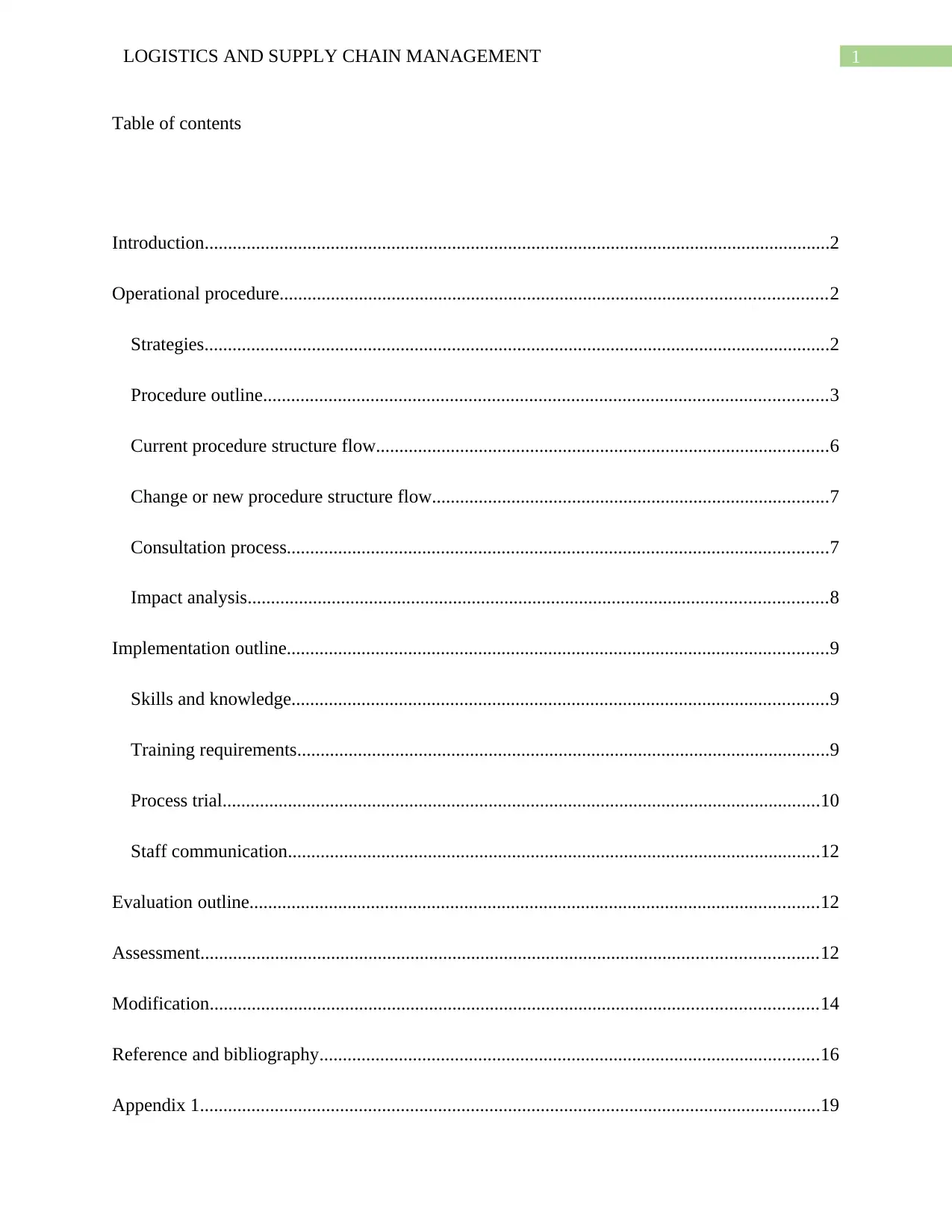
1LOGISTICS AND SUPPLY CHAIN MANAGEMENT
Table of contents
Introduction......................................................................................................................................2
Operational procedure.....................................................................................................................2
Strategies......................................................................................................................................2
Procedure outline.........................................................................................................................3
Current procedure structure flow.................................................................................................6
Change or new procedure structure flow.....................................................................................7
Consultation process....................................................................................................................7
Impact analysis............................................................................................................................8
Implementation outline....................................................................................................................9
Skills and knowledge...................................................................................................................9
Training requirements..................................................................................................................9
Process trial................................................................................................................................10
Staff communication..................................................................................................................12
Evaluation outline..........................................................................................................................12
Assessment....................................................................................................................................12
Modification..................................................................................................................................14
Reference and bibliography...........................................................................................................16
Appendix 1.....................................................................................................................................19
Table of contents
Introduction......................................................................................................................................2
Operational procedure.....................................................................................................................2
Strategies......................................................................................................................................2
Procedure outline.........................................................................................................................3
Current procedure structure flow.................................................................................................6
Change or new procedure structure flow.....................................................................................7
Consultation process....................................................................................................................7
Impact analysis............................................................................................................................8
Implementation outline....................................................................................................................9
Skills and knowledge...................................................................................................................9
Training requirements..................................................................................................................9
Process trial................................................................................................................................10
Staff communication..................................................................................................................12
Evaluation outline..........................................................................................................................12
Assessment....................................................................................................................................12
Modification..................................................................................................................................14
Reference and bibliography...........................................................................................................16
Appendix 1.....................................................................................................................................19

2LOGISTICS AND SUPPLY CHAIN MANAGEMENT
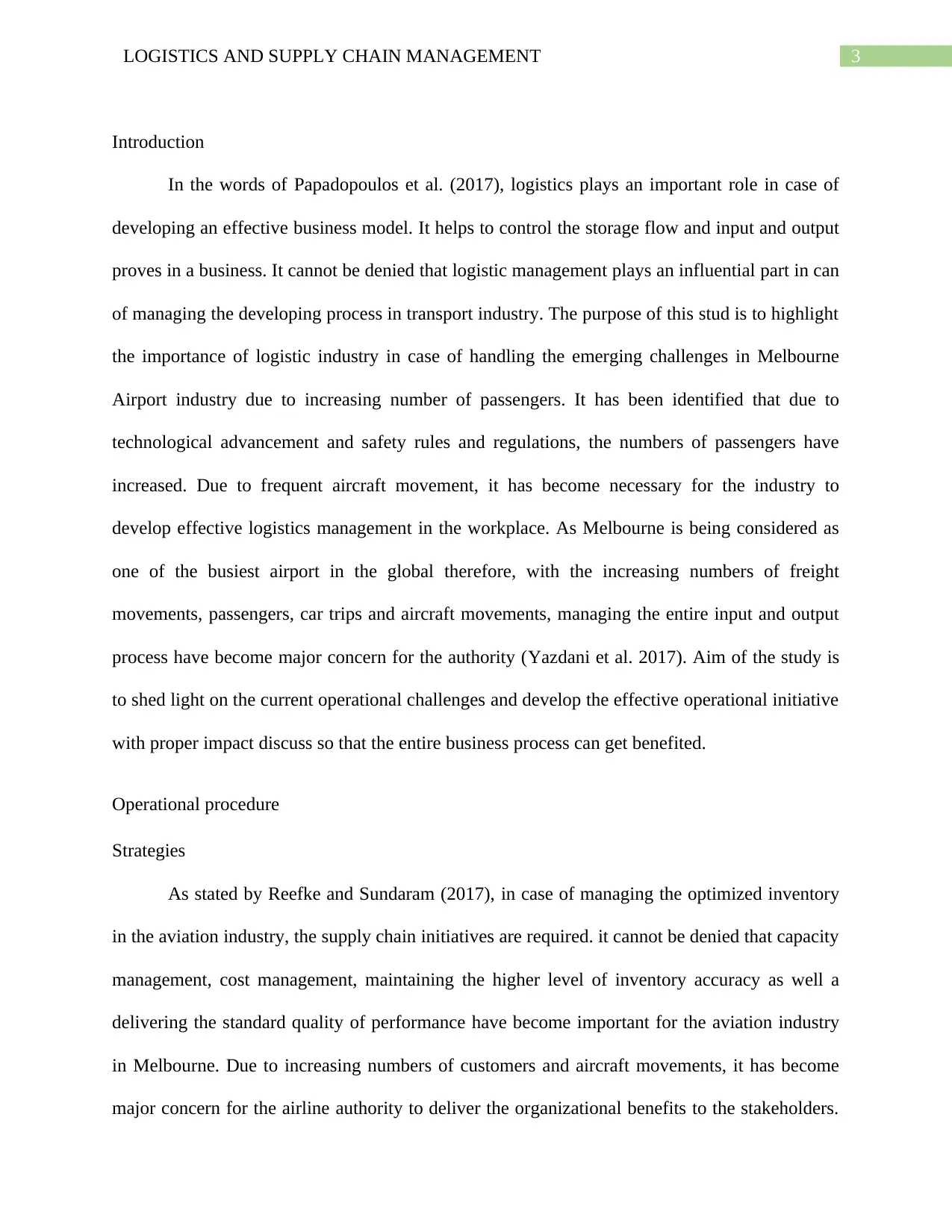
3LOGISTICS AND SUPPLY CHAIN MANAGEMENT
Introduction
In the words of Papadopoulos et al. (2017), logistics plays an important role in case of
developing an effective business model. It helps to control the storage flow and input and output
proves in a business. It cannot be denied that logistic management plays an influential part in can
of managing the developing process in transport industry. The purpose of this stud is to highlight
the importance of logistic industry in case of handling the emerging challenges in Melbourne
Airport industry due to increasing number of passengers. It has been identified that due to
technological advancement and safety rules and regulations, the numbers of passengers have
increased. Due to frequent aircraft movement, it has become necessary for the industry to
develop effective logistics management in the workplace. As Melbourne is being considered as
one of the busiest airport in the global therefore, with the increasing numbers of freight
movements, passengers, car trips and aircraft movements, managing the entire input and output
process have become major concern for the authority (Yazdani et al. 2017). Aim of the study is
to shed light on the current operational challenges and develop the effective operational initiative
with proper impact discuss so that the entire business process can get benefited.
Operational procedure
Strategies
As stated by Reefke and Sundaram (2017), in case of managing the optimized inventory
in the aviation industry, the supply chain initiatives are required. it cannot be denied that capacity
management, cost management, maintaining the higher level of inventory accuracy as well a
delivering the standard quality of performance have become important for the aviation industry
in Melbourne. Due to increasing numbers of customers and aircraft movements, it has become
major concern for the airline authority to deliver the organizational benefits to the stakeholders.
Introduction
In the words of Papadopoulos et al. (2017), logistics plays an important role in case of
developing an effective business model. It helps to control the storage flow and input and output
proves in a business. It cannot be denied that logistic management plays an influential part in can
of managing the developing process in transport industry. The purpose of this stud is to highlight
the importance of logistic industry in case of handling the emerging challenges in Melbourne
Airport industry due to increasing number of passengers. It has been identified that due to
technological advancement and safety rules and regulations, the numbers of passengers have
increased. Due to frequent aircraft movement, it has become necessary for the industry to
develop effective logistics management in the workplace. As Melbourne is being considered as
one of the busiest airport in the global therefore, with the increasing numbers of freight
movements, passengers, car trips and aircraft movements, managing the entire input and output
process have become major concern for the authority (Yazdani et al. 2017). Aim of the study is
to shed light on the current operational challenges and develop the effective operational initiative
with proper impact discuss so that the entire business process can get benefited.
Operational procedure
Strategies
As stated by Reefke and Sundaram (2017), in case of managing the optimized inventory
in the aviation industry, the supply chain initiatives are required. it cannot be denied that capacity
management, cost management, maintaining the higher level of inventory accuracy as well a
delivering the standard quality of performance have become important for the aviation industry
in Melbourne. Due to increasing numbers of customers and aircraft movements, it has become
major concern for the airline authority to deliver the organizational benefits to the stakeholders.
Secure Best Marks with AI Grader
Need help grading? Try our AI Grader for instant feedback on your assignments.
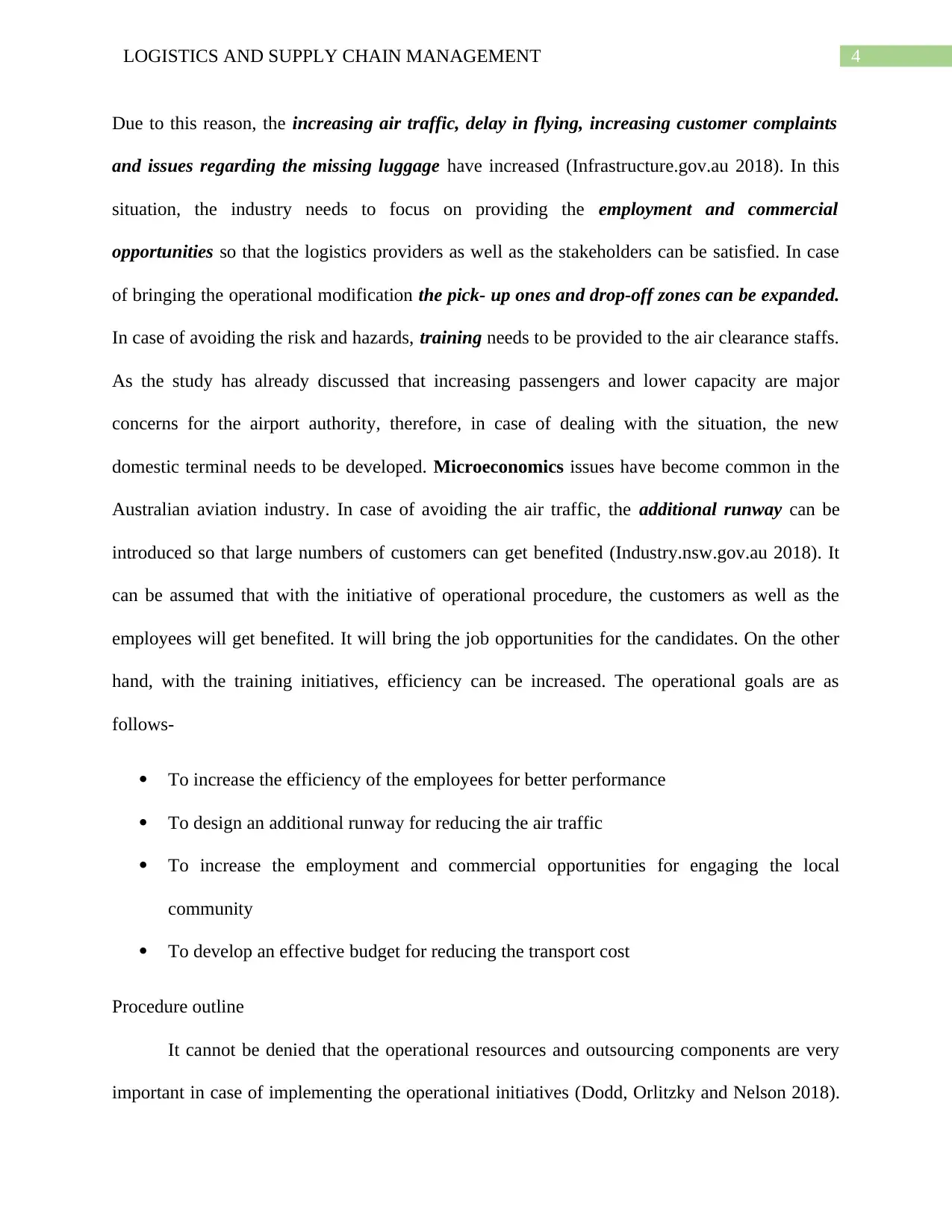
4LOGISTICS AND SUPPLY CHAIN MANAGEMENT
Due to this reason, the increasing air traffic, delay in flying, increasing customer complaints
and issues regarding the missing luggage have increased (Infrastructure.gov.au 2018). In this
situation, the industry needs to focus on providing the employment and commercial
opportunities so that the logistics providers as well as the stakeholders can be satisfied. In case
of bringing the operational modification the pick- up ones and drop-off zones can be expanded.
In case of avoiding the risk and hazards, training needs to be provided to the air clearance staffs.
As the study has already discussed that increasing passengers and lower capacity are major
concerns for the airport authority, therefore, in case of dealing with the situation, the new
domestic terminal needs to be developed. Microeconomics issues have become common in the
Australian aviation industry. In case of avoiding the air traffic, the additional runway can be
introduced so that large numbers of customers can get benefited (Industry.nsw.gov.au 2018). It
can be assumed that with the initiative of operational procedure, the customers as well as the
employees will get benefited. It will bring the job opportunities for the candidates. On the other
hand, with the training initiatives, efficiency can be increased. The operational goals are as
follows-
To increase the efficiency of the employees for better performance
To design an additional runway for reducing the air traffic
To increase the employment and commercial opportunities for engaging the local
community
To develop an effective budget for reducing the transport cost
Procedure outline
It cannot be denied that the operational resources and outsourcing components are very
important in case of implementing the operational initiatives (Dodd, Orlitzky and Nelson 2018).
Due to this reason, the increasing air traffic, delay in flying, increasing customer complaints
and issues regarding the missing luggage have increased (Infrastructure.gov.au 2018). In this
situation, the industry needs to focus on providing the employment and commercial
opportunities so that the logistics providers as well as the stakeholders can be satisfied. In case
of bringing the operational modification the pick- up ones and drop-off zones can be expanded.
In case of avoiding the risk and hazards, training needs to be provided to the air clearance staffs.
As the study has already discussed that increasing passengers and lower capacity are major
concerns for the airport authority, therefore, in case of dealing with the situation, the new
domestic terminal needs to be developed. Microeconomics issues have become common in the
Australian aviation industry. In case of avoiding the air traffic, the additional runway can be
introduced so that large numbers of customers can get benefited (Industry.nsw.gov.au 2018). It
can be assumed that with the initiative of operational procedure, the customers as well as the
employees will get benefited. It will bring the job opportunities for the candidates. On the other
hand, with the training initiatives, efficiency can be increased. The operational goals are as
follows-
To increase the efficiency of the employees for better performance
To design an additional runway for reducing the air traffic
To increase the employment and commercial opportunities for engaging the local
community
To develop an effective budget for reducing the transport cost
Procedure outline
It cannot be denied that the operational resources and outsourcing components are very
important in case of implementing the operational initiatives (Dodd, Orlitzky and Nelson 2018).
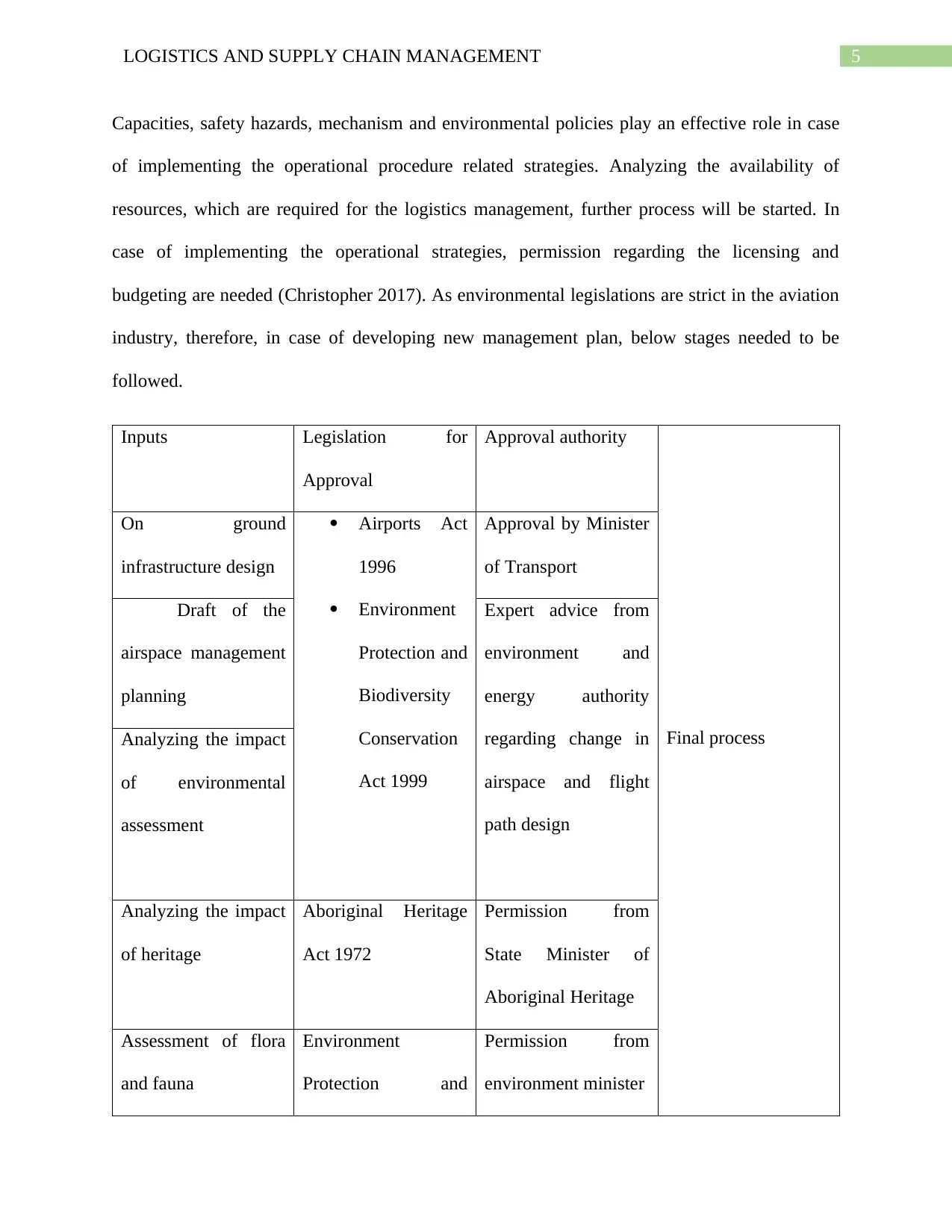
5LOGISTICS AND SUPPLY CHAIN MANAGEMENT
Capacities, safety hazards, mechanism and environmental policies play an effective role in case
of implementing the operational procedure related strategies. Analyzing the availability of
resources, which are required for the logistics management, further process will be started. In
case of implementing the operational strategies, permission regarding the licensing and
budgeting are needed (Christopher 2017). As environmental legislations are strict in the aviation
industry, therefore, in case of developing new management plan, below stages needed to be
followed.
Inputs Legislation for
Approval
Approval authority
Final process
On ground
infrastructure design
Airports Act
1996
Environment
Protection and
Biodiversity
Conservation
Act 1999
Approval by Minister
of Transport
Draft of the
airspace management
planning
Expert advice from
environment and
energy authority
regarding change in
airspace and flight
path design
Analyzing the impact
of environmental
assessment
Analyzing the impact
of heritage
Aboriginal Heritage
Act 1972
Permission from
State Minister of
Aboriginal Heritage
Assessment of flora
and fauna
Environment
Protection and
Permission from
environment minister
Capacities, safety hazards, mechanism and environmental policies play an effective role in case
of implementing the operational procedure related strategies. Analyzing the availability of
resources, which are required for the logistics management, further process will be started. In
case of implementing the operational strategies, permission regarding the licensing and
budgeting are needed (Christopher 2017). As environmental legislations are strict in the aviation
industry, therefore, in case of developing new management plan, below stages needed to be
followed.
Inputs Legislation for
Approval
Approval authority
Final process
On ground
infrastructure design
Airports Act
1996
Environment
Protection and
Biodiversity
Conservation
Act 1999
Approval by Minister
of Transport
Draft of the
airspace management
planning
Expert advice from
environment and
energy authority
regarding change in
airspace and flight
path design
Analyzing the impact
of environmental
assessment
Analyzing the impact
of heritage
Aboriginal Heritage
Act 1972
Permission from
State Minister of
Aboriginal Heritage
Assessment of flora
and fauna
Environment
Protection and
Permission from
environment minister
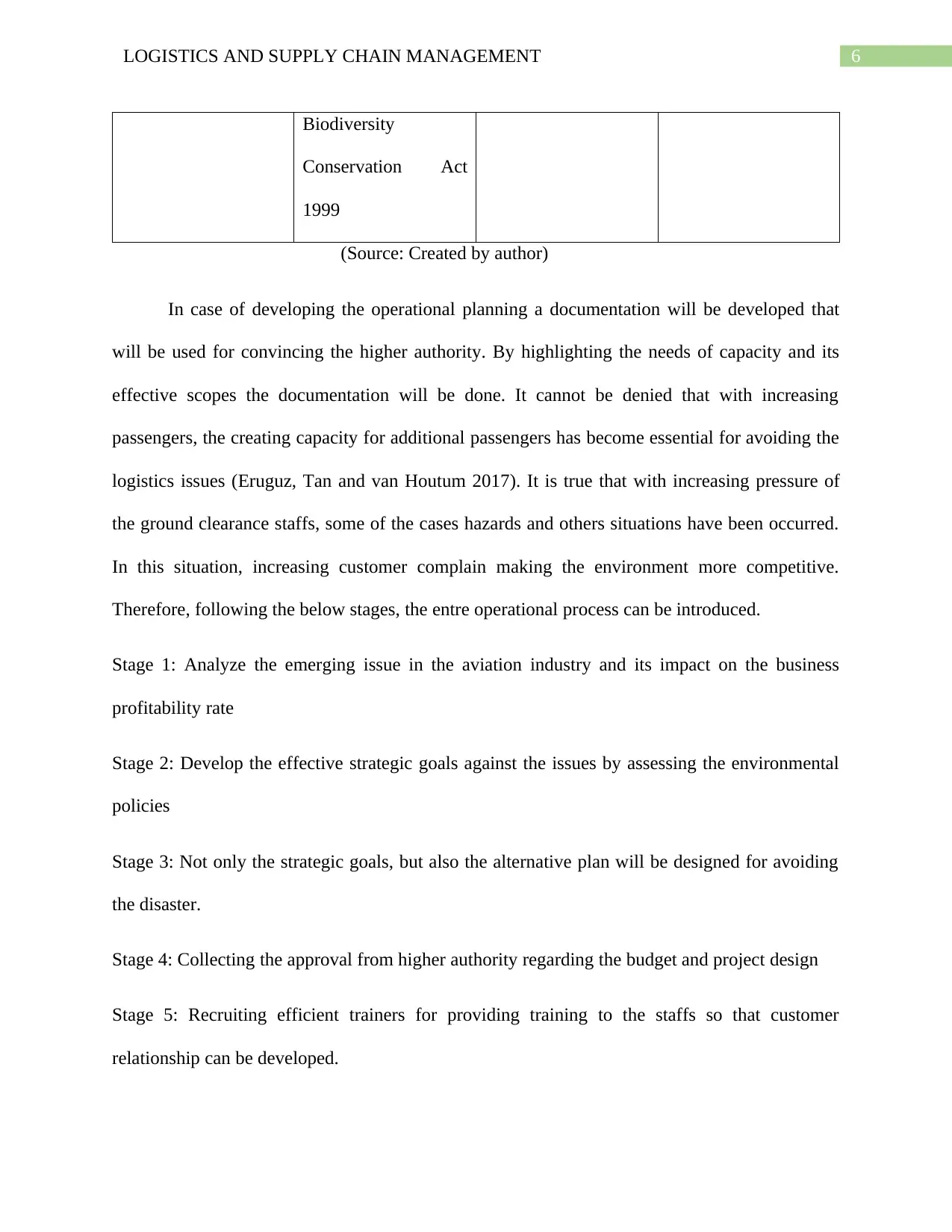
6LOGISTICS AND SUPPLY CHAIN MANAGEMENT
Biodiversity
Conservation Act
1999
(Source: Created by author)
In case of developing the operational planning a documentation will be developed that
will be used for convincing the higher authority. By highlighting the needs of capacity and its
effective scopes the documentation will be done. It cannot be denied that with increasing
passengers, the creating capacity for additional passengers has become essential for avoiding the
logistics issues (Eruguz, Tan and van Houtum 2017). It is true that with increasing pressure of
the ground clearance staffs, some of the cases hazards and others situations have been occurred.
In this situation, increasing customer complain making the environment more competitive.
Therefore, following the below stages, the entre operational process can be introduced.
Stage 1: Analyze the emerging issue in the aviation industry and its impact on the business
profitability rate
Stage 2: Develop the effective strategic goals against the issues by assessing the environmental
policies
Stage 3: Not only the strategic goals, but also the alternative plan will be designed for avoiding
the disaster.
Stage 4: Collecting the approval from higher authority regarding the budget and project design
Stage 5: Recruiting efficient trainers for providing training to the staffs so that customer
relationship can be developed.
Biodiversity
Conservation Act
1999
(Source: Created by author)
In case of developing the operational planning a documentation will be developed that
will be used for convincing the higher authority. By highlighting the needs of capacity and its
effective scopes the documentation will be done. It cannot be denied that with increasing
passengers, the creating capacity for additional passengers has become essential for avoiding the
logistics issues (Eruguz, Tan and van Houtum 2017). It is true that with increasing pressure of
the ground clearance staffs, some of the cases hazards and others situations have been occurred.
In this situation, increasing customer complain making the environment more competitive.
Therefore, following the below stages, the entre operational process can be introduced.
Stage 1: Analyze the emerging issue in the aviation industry and its impact on the business
profitability rate
Stage 2: Develop the effective strategic goals against the issues by assessing the environmental
policies
Stage 3: Not only the strategic goals, but also the alternative plan will be designed for avoiding
the disaster.
Stage 4: Collecting the approval from higher authority regarding the budget and project design
Stage 5: Recruiting efficient trainers for providing training to the staffs so that customer
relationship can be developed.
Paraphrase This Document
Need a fresh take? Get an instant paraphrase of this document with our AI Paraphraser

7LOGISTICS AND SUPPLY CHAIN MANAGEMENT
Stage 6: After the 12months of training and development plan trial will be done.
Stage 7: Depending on the requirements further modification will be done.
Current procedure structure flow
Figure: Current procedure structure flow
(Source: created by author)
Increasing
passenger
and aircraft
movement
lack of
training
Air
clearence
issue
Improper
planning
lack of
space
Falling
business
revenue
Stage 6: After the 12months of training and development plan trial will be done.
Stage 7: Depending on the requirements further modification will be done.
Current procedure structure flow
Figure: Current procedure structure flow
(Source: created by author)
Increasing
passenger
and aircraft
movement
lack of
training
Air
clearence
issue
Improper
planning
lack of
space
Falling
business
revenue

8LOGISTICS AND SUPPLY CHAIN MANAGEMENT
Change or new procedure structure flow
Figure: Change or new procedure structure flow
(Source: created by author)
Consultation process
As logistics is the large project for aviation industry, therefore, involvement of
stakeholders are very important for implementing the strategic goals. Economic participants such
as investors and finance experts are very important for implementing a proper strategic planning.
Before implementing the operational initiatives the budgeting will be done by consulting with
the financial advisors. In case of developing a new runway, the role of airport organizers are
very important. After developing the design, the approval from the airport organizations will be
needed. In case of bringing the changes in logistics management, the commuter carriers, small
certified carriers and large certified carriers are important. On the other hand, the corporate
executive, transportation, aerial application manager, local community and the passengers are
Designing
addiotional
runway
Increase
employment
oppoerunity
training
needs
analysis
Reduce the
air traffic
Increase
performance
standared
Reduce
customer
complaints
Change or new procedure structure flow
Figure: Change or new procedure structure flow
(Source: created by author)
Consultation process
As logistics is the large project for aviation industry, therefore, involvement of
stakeholders are very important for implementing the strategic goals. Economic participants such
as investors and finance experts are very important for implementing a proper strategic planning.
Before implementing the operational initiatives the budgeting will be done by consulting with
the financial advisors. In case of developing a new runway, the role of airport organizers are
very important. After developing the design, the approval from the airport organizations will be
needed. In case of bringing the changes in logistics management, the commuter carriers, small
certified carriers and large certified carriers are important. On the other hand, the corporate
executive, transportation, aerial application manager, local community and the passengers are
Designing
addiotional
runway
Increase
employment
oppoerunity
training
needs
analysis
Reduce the
air traffic
Increase
performance
standared
Reduce
customer
complaints

9LOGISTICS AND SUPPLY CHAIN MANAGEMENT
equally important in case of implementing the operational changes. Without the efficiency of the
employees the implementation cannot be possible.
Proper budget will be developed and discussed with investors and finance department.
In case of identifying the efficiency of runway designing process, the project designing team will
be recruited for introducing the runway design. A documentation will be developed, where the
details of final documentation will be provided and will be presented to the ministry. After the
approval, the entire operation will be started.
Impact analysis
It can be assumed that the entre logistics management planning will be beneficial in terms
of contributing in cost cutting. With the strategic initiatives, the improvement in business
process can be introduced. With the increasing employment opportunities, customers can be
satisfied easily. On the other hand, it is true that it will be beneficial in terms of engaging the
large numbers of local community, which can influence the rate of business profitability. It can
be assumed that it will be beneficial in terms of bringing the economic opportunities in the
workplace. Technological implementation can help to reduce the labor cost and help to
manage the inventory in proper manner. On the other hand, it is true that if proper training will
be provided to the employees, it will help to expand sourcing in the new market. It is true that by
increasing the commercial opportunities in the market, the aviation industry will be able to deal
with the emerging operational issues.
equally important in case of implementing the operational changes. Without the efficiency of the
employees the implementation cannot be possible.
Proper budget will be developed and discussed with investors and finance department.
In case of identifying the efficiency of runway designing process, the project designing team will
be recruited for introducing the runway design. A documentation will be developed, where the
details of final documentation will be provided and will be presented to the ministry. After the
approval, the entire operation will be started.
Impact analysis
It can be assumed that the entre logistics management planning will be beneficial in terms
of contributing in cost cutting. With the strategic initiatives, the improvement in business
process can be introduced. With the increasing employment opportunities, customers can be
satisfied easily. On the other hand, it is true that it will be beneficial in terms of engaging the
large numbers of local community, which can influence the rate of business profitability. It can
be assumed that it will be beneficial in terms of bringing the economic opportunities in the
workplace. Technological implementation can help to reduce the labor cost and help to
manage the inventory in proper manner. On the other hand, it is true that if proper training will
be provided to the employees, it will help to expand sourcing in the new market. It is true that by
increasing the commercial opportunities in the market, the aviation industry will be able to deal
with the emerging operational issues.
Secure Best Marks with AI Grader
Need help grading? Try our AI Grader for instant feedback on your assignments.
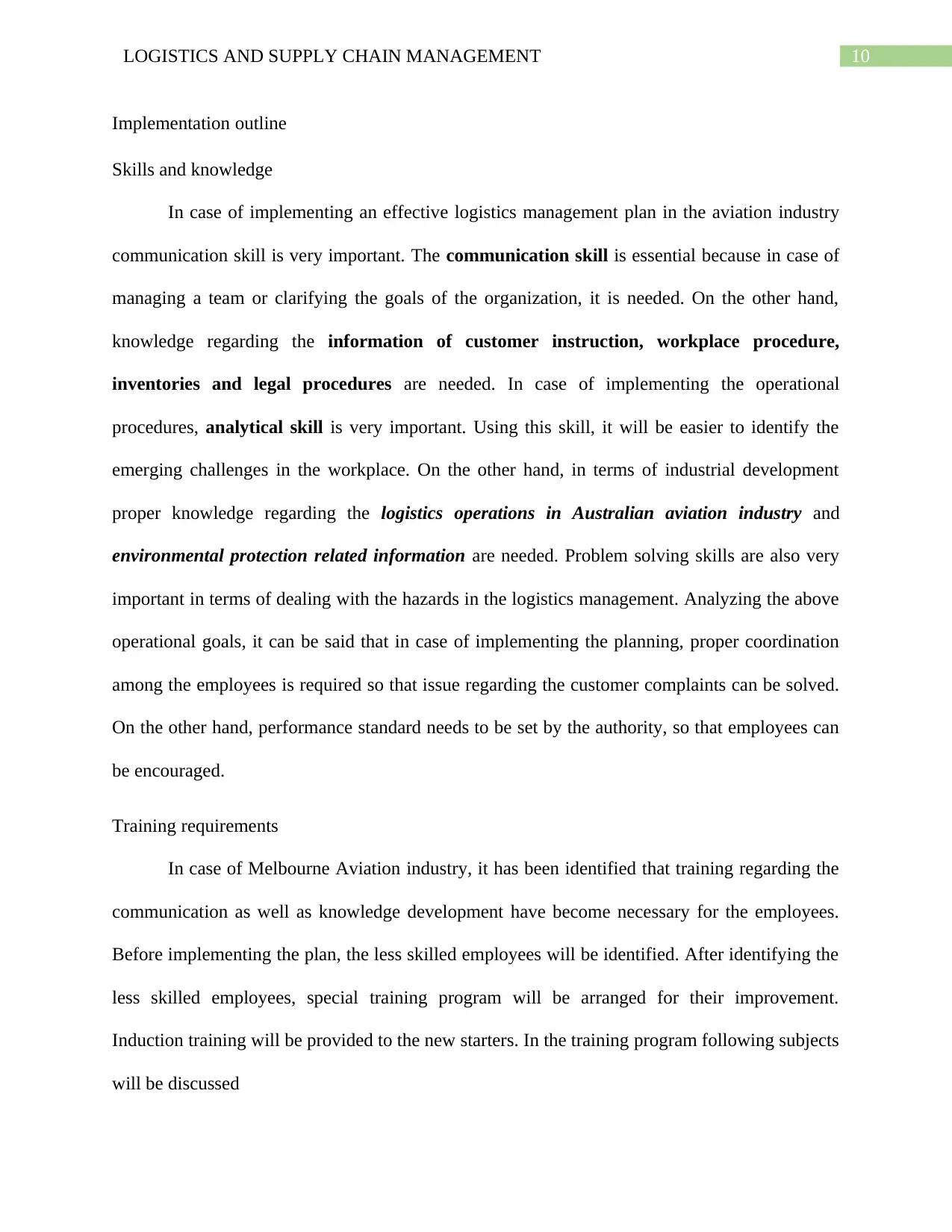
10LOGISTICS AND SUPPLY CHAIN MANAGEMENT
Implementation outline
Skills and knowledge
In case of implementing an effective logistics management plan in the aviation industry
communication skill is very important. The communication skill is essential because in case of
managing a team or clarifying the goals of the organization, it is needed. On the other hand,
knowledge regarding the information of customer instruction, workplace procedure,
inventories and legal procedures are needed. In case of implementing the operational
procedures, analytical skill is very important. Using this skill, it will be easier to identify the
emerging challenges in the workplace. On the other hand, in terms of industrial development
proper knowledge regarding the logistics operations in Australian aviation industry and
environmental protection related information are needed. Problem solving skills are also very
important in terms of dealing with the hazards in the logistics management. Analyzing the above
operational goals, it can be said that in case of implementing the planning, proper coordination
among the employees is required so that issue regarding the customer complaints can be solved.
On the other hand, performance standard needs to be set by the authority, so that employees can
be encouraged.
Training requirements
In case of Melbourne Aviation industry, it has been identified that training regarding the
communication as well as knowledge development have become necessary for the employees.
Before implementing the plan, the less skilled employees will be identified. After identifying the
less skilled employees, special training program will be arranged for their improvement.
Induction training will be provided to the new starters. In the training program following subjects
will be discussed
Implementation outline
Skills and knowledge
In case of implementing an effective logistics management plan in the aviation industry
communication skill is very important. The communication skill is essential because in case of
managing a team or clarifying the goals of the organization, it is needed. On the other hand,
knowledge regarding the information of customer instruction, workplace procedure,
inventories and legal procedures are needed. In case of implementing the operational
procedures, analytical skill is very important. Using this skill, it will be easier to identify the
emerging challenges in the workplace. On the other hand, in terms of industrial development
proper knowledge regarding the logistics operations in Australian aviation industry and
environmental protection related information are needed. Problem solving skills are also very
important in terms of dealing with the hazards in the logistics management. Analyzing the above
operational goals, it can be said that in case of implementing the planning, proper coordination
among the employees is required so that issue regarding the customer complaints can be solved.
On the other hand, performance standard needs to be set by the authority, so that employees can
be encouraged.
Training requirements
In case of Melbourne Aviation industry, it has been identified that training regarding the
communication as well as knowledge development have become necessary for the employees.
Before implementing the plan, the less skilled employees will be identified. After identifying the
less skilled employees, special training program will be arranged for their improvement.
Induction training will be provided to the new starters. In the training program following subjects
will be discussed

11LOGISTICS AND SUPPLY CHAIN MANAGEMENT
Goals and objectives will be clarified
Technological training will be provided
Legations will be clarified
Employees will be asked to provide their opinion regarding the situation
Operational and quality requirements will be clarified
Different workshop can be developed for improving the communication skills of the
employees
In case of analyzing the benefits of the planning a trial will be done so that its
consequences can be assumed. A performance matrix can be introduced so that if the employees
are improving or not can be identified. After implementing the operational procedures plan,
feedbacks from the employees will be collected. In case of collecting the feedbacks from the
employees a questionnaire can be developed (refer to appendix 1).
Process trial
For the purpose of process trail, the five stages of diffusion should be considered.
Goals and objectives will be clarified
Technological training will be provided
Legations will be clarified
Employees will be asked to provide their opinion regarding the situation
Operational and quality requirements will be clarified
Different workshop can be developed for improving the communication skills of the
employees
In case of analyzing the benefits of the planning a trial will be done so that its
consequences can be assumed. A performance matrix can be introduced so that if the employees
are improving or not can be identified. After implementing the operational procedures plan,
feedbacks from the employees will be collected. In case of collecting the feedbacks from the
employees a questionnaire can be developed (refer to appendix 1).
Process trial
For the purpose of process trail, the five stages of diffusion should be considered.
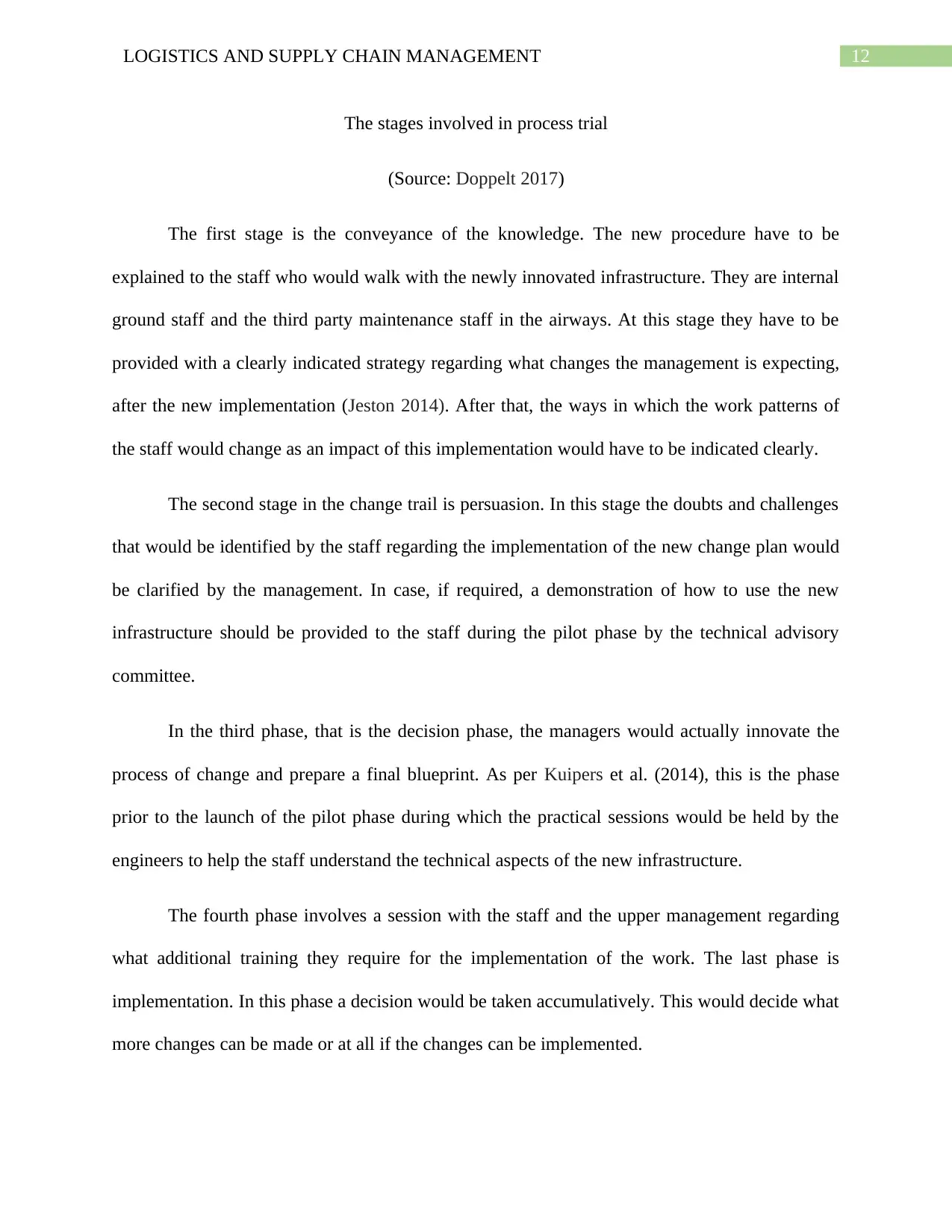
12LOGISTICS AND SUPPLY CHAIN MANAGEMENT
The stages involved in process trial
(Source: Doppelt 2017)
The first stage is the conveyance of the knowledge. The new procedure have to be
explained to the staff who would walk with the newly innovated infrastructure. They are internal
ground staff and the third party maintenance staff in the airways. At this stage they have to be
provided with a clearly indicated strategy regarding what changes the management is expecting,
after the new implementation (Jeston 2014). After that, the ways in which the work patterns of
the staff would change as an impact of this implementation would have to be indicated clearly.
The second stage in the change trail is persuasion. In this stage the doubts and challenges
that would be identified by the staff regarding the implementation of the new change plan would
be clarified by the management. In case, if required, a demonstration of how to use the new
infrastructure should be provided to the staff during the pilot phase by the technical advisory
committee.
In the third phase, that is the decision phase, the managers would actually innovate the
process of change and prepare a final blueprint. As per Kuipers et al. (2014), this is the phase
prior to the launch of the pilot phase during which the practical sessions would be held by the
engineers to help the staff understand the technical aspects of the new infrastructure.
The fourth phase involves a session with the staff and the upper management regarding
what additional training they require for the implementation of the work. The last phase is
implementation. In this phase a decision would be taken accumulatively. This would decide what
more changes can be made or at all if the changes can be implemented.
The stages involved in process trial
(Source: Doppelt 2017)
The first stage is the conveyance of the knowledge. The new procedure have to be
explained to the staff who would walk with the newly innovated infrastructure. They are internal
ground staff and the third party maintenance staff in the airways. At this stage they have to be
provided with a clearly indicated strategy regarding what changes the management is expecting,
after the new implementation (Jeston 2014). After that, the ways in which the work patterns of
the staff would change as an impact of this implementation would have to be indicated clearly.
The second stage in the change trail is persuasion. In this stage the doubts and challenges
that would be identified by the staff regarding the implementation of the new change plan would
be clarified by the management. In case, if required, a demonstration of how to use the new
infrastructure should be provided to the staff during the pilot phase by the technical advisory
committee.
In the third phase, that is the decision phase, the managers would actually innovate the
process of change and prepare a final blueprint. As per Kuipers et al. (2014), this is the phase
prior to the launch of the pilot phase during which the practical sessions would be held by the
engineers to help the staff understand the technical aspects of the new infrastructure.
The fourth phase involves a session with the staff and the upper management regarding
what additional training they require for the implementation of the work. The last phase is
implementation. In this phase a decision would be taken accumulatively. This would decide what
more changes can be made or at all if the changes can be implemented.
Paraphrase This Document
Need a fresh take? Get an instant paraphrase of this document with our AI Paraphraser
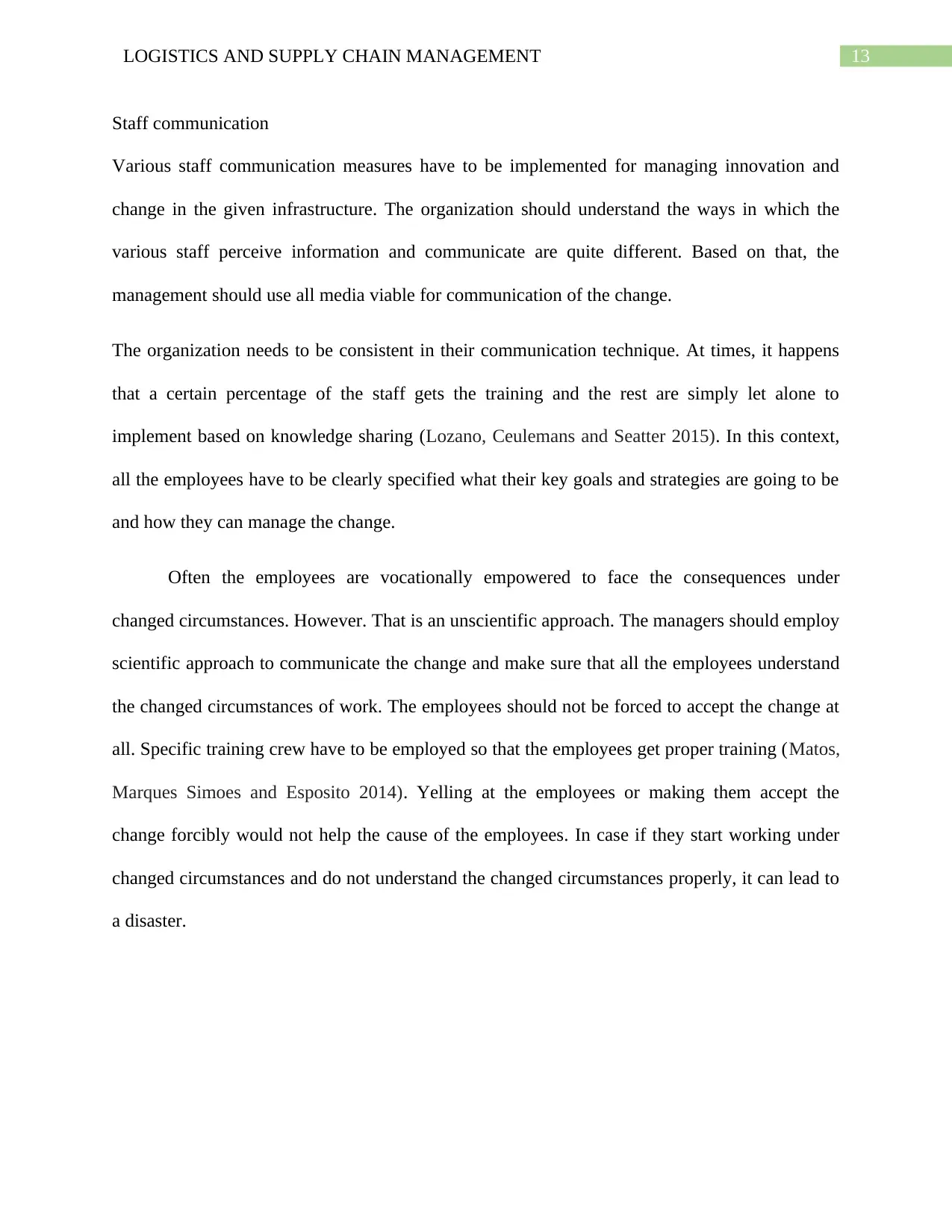
13LOGISTICS AND SUPPLY CHAIN MANAGEMENT
Staff communication
Various staff communication measures have to be implemented for managing innovation and
change in the given infrastructure. The organization should understand the ways in which the
various staff perceive information and communicate are quite different. Based on that, the
management should use all media viable for communication of the change.
The organization needs to be consistent in their communication technique. At times, it happens
that a certain percentage of the staff gets the training and the rest are simply let alone to
implement based on knowledge sharing (Lozano, Ceulemans and Seatter 2015). In this context,
all the employees have to be clearly specified what their key goals and strategies are going to be
and how they can manage the change.
Often the employees are vocationally empowered to face the consequences under
changed circumstances. However. That is an unscientific approach. The managers should employ
scientific approach to communicate the change and make sure that all the employees understand
the changed circumstances of work. The employees should not be forced to accept the change at
all. Specific training crew have to be employed so that the employees get proper training (Matos,
Marques Simoes and Esposito 2014). Yelling at the employees or making them accept the
change forcibly would not help the cause of the employees. In case if they start working under
changed circumstances and do not understand the changed circumstances properly, it can lead to
a disaster.
Staff communication
Various staff communication measures have to be implemented for managing innovation and
change in the given infrastructure. The organization should understand the ways in which the
various staff perceive information and communicate are quite different. Based on that, the
management should use all media viable for communication of the change.
The organization needs to be consistent in their communication technique. At times, it happens
that a certain percentage of the staff gets the training and the rest are simply let alone to
implement based on knowledge sharing (Lozano, Ceulemans and Seatter 2015). In this context,
all the employees have to be clearly specified what their key goals and strategies are going to be
and how they can manage the change.
Often the employees are vocationally empowered to face the consequences under
changed circumstances. However. That is an unscientific approach. The managers should employ
scientific approach to communicate the change and make sure that all the employees understand
the changed circumstances of work. The employees should not be forced to accept the change at
all. Specific training crew have to be employed so that the employees get proper training (Matos,
Marques Simoes and Esposito 2014). Yelling at the employees or making them accept the
change forcibly would not help the cause of the employees. In case if they start working under
changed circumstances and do not understand the changed circumstances properly, it can lead to
a disaster.
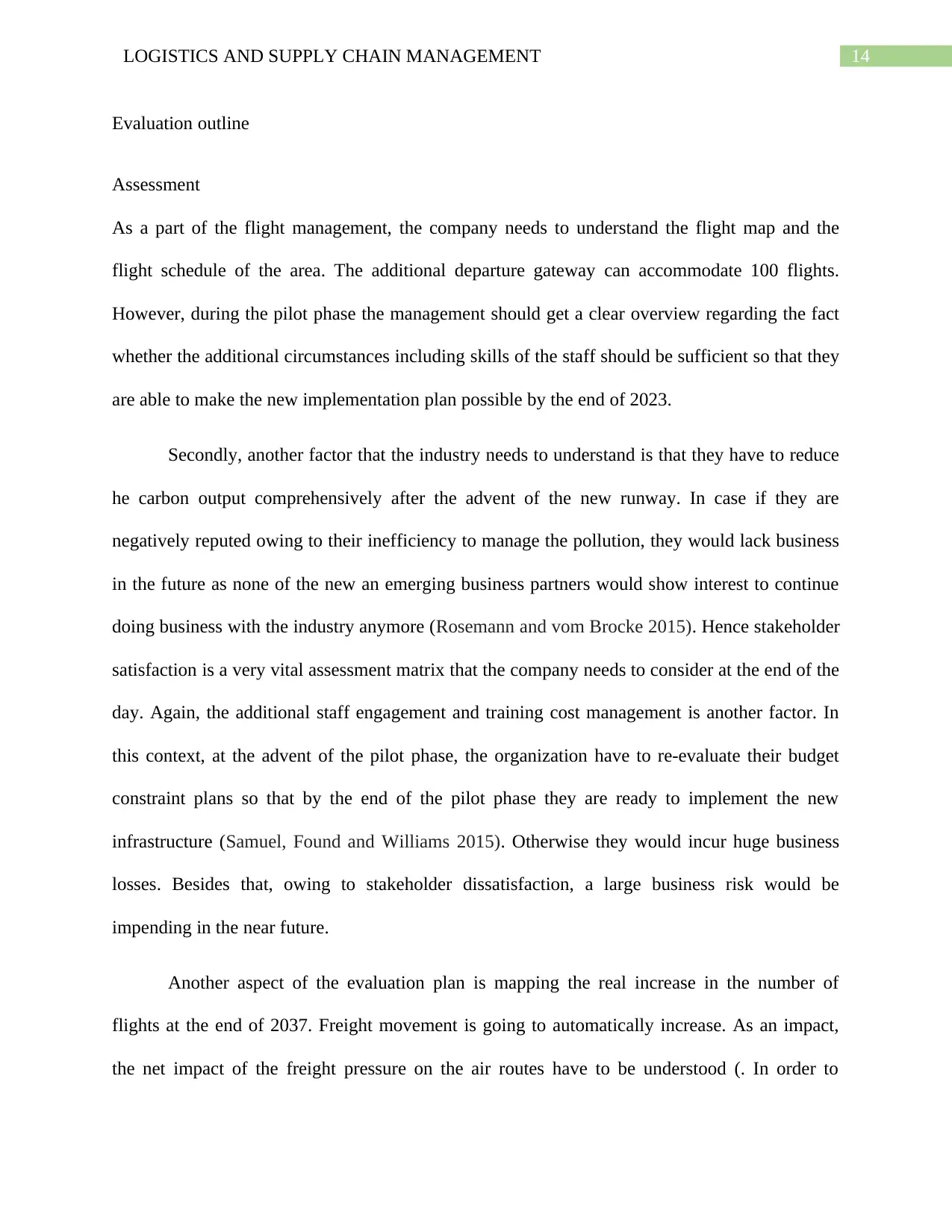
14LOGISTICS AND SUPPLY CHAIN MANAGEMENT
Evaluation outline
Assessment
As a part of the flight management, the company needs to understand the flight map and the
flight schedule of the area. The additional departure gateway can accommodate 100 flights.
However, during the pilot phase the management should get a clear overview regarding the fact
whether the additional circumstances including skills of the staff should be sufficient so that they
are able to make the new implementation plan possible by the end of 2023.
Secondly, another factor that the industry needs to understand is that they have to reduce
he carbon output comprehensively after the advent of the new runway. In case if they are
negatively reputed owing to their inefficiency to manage the pollution, they would lack business
in the future as none of the new an emerging business partners would show interest to continue
doing business with the industry anymore (Rosemann and vom Brocke 2015). Hence stakeholder
satisfaction is a very vital assessment matrix that the company needs to consider at the end of the
day. Again, the additional staff engagement and training cost management is another factor. In
this context, at the advent of the pilot phase, the organization have to re-evaluate their budget
constraint plans so that by the end of the pilot phase they are ready to implement the new
infrastructure (Samuel, Found and Williams 2015). Otherwise they would incur huge business
losses. Besides that, owing to stakeholder dissatisfaction, a large business risk would be
impending in the near future.
Another aspect of the evaluation plan is mapping the real increase in the number of
flights at the end of 2037. Freight movement is going to automatically increase. As an impact,
the net impact of the freight pressure on the air routes have to be understood (. In order to
Evaluation outline
Assessment
As a part of the flight management, the company needs to understand the flight map and the
flight schedule of the area. The additional departure gateway can accommodate 100 flights.
However, during the pilot phase the management should get a clear overview regarding the fact
whether the additional circumstances including skills of the staff should be sufficient so that they
are able to make the new implementation plan possible by the end of 2023.
Secondly, another factor that the industry needs to understand is that they have to reduce
he carbon output comprehensively after the advent of the new runway. In case if they are
negatively reputed owing to their inefficiency to manage the pollution, they would lack business
in the future as none of the new an emerging business partners would show interest to continue
doing business with the industry anymore (Rosemann and vom Brocke 2015). Hence stakeholder
satisfaction is a very vital assessment matrix that the company needs to consider at the end of the
day. Again, the additional staff engagement and training cost management is another factor. In
this context, at the advent of the pilot phase, the organization have to re-evaluate their budget
constraint plans so that by the end of the pilot phase they are ready to implement the new
infrastructure (Samuel, Found and Williams 2015). Otherwise they would incur huge business
losses. Besides that, owing to stakeholder dissatisfaction, a large business risk would be
impending in the near future.
Another aspect of the evaluation plan is mapping the real increase in the number of
flights at the end of 2037. Freight movement is going to automatically increase. As an impact,
the net impact of the freight pressure on the air routes have to be understood (. In order to

15LOGISTICS AND SUPPLY CHAIN MANAGEMENT
understand this, pilot run of additional planes have to be conducted in order to understand how
much additional traffic pressure the newly renovated airway can take up for the future (Stark
2015). This is essential for the fact that already a huge investment is being done for revamping in
2023. In case if the project fails, there would be huge financial losses and public as well as
political liabilities incurred.
The industry also needs to assess the associated changes for the newly built
infrastructure. The pressure on the road traffic would also increase as an impact of the increase in
the number of the new flights. Already the vehicle count per hour in the airport vicinity is
127000. This might get doubled after 10 years owing to the rapid increase in the number of air
travelers by the end of 2038. This is why, the civil infrastructure and the municipal development
department have to be consulted regarding the construction of fly-overs and more by-lanes in the
area so that the people can no issues in arriving and leaving the airport (Belias and Koustelios
2014).
Modification
The primary modifications are appointment of more staff for the new domestic terminal
that is to come in to operations by 2023. The staff have to be given proper training to handle
international travelers. The airport authorities have to take care that the flight timings are
properly adjusted. This is why an intranet software have to be created whereby the flight
channels can be properly sorted and all concerned flight management staff at the airport becomes
authorized to schedule and reschedule the flight lanes without the hassle of higher
communication (Theriou 2015). Moreover, another factor is that the ground and cover area of the
airport have to be enlarged. The parking zone have to be enlarged by at least 500 square yards.
Automatic entry metal checking instruments have to be installed so that the ground management
understand this, pilot run of additional planes have to be conducted in order to understand how
much additional traffic pressure the newly renovated airway can take up for the future (Stark
2015). This is essential for the fact that already a huge investment is being done for revamping in
2023. In case if the project fails, there would be huge financial losses and public as well as
political liabilities incurred.
The industry also needs to assess the associated changes for the newly built
infrastructure. The pressure on the road traffic would also increase as an impact of the increase in
the number of the new flights. Already the vehicle count per hour in the airport vicinity is
127000. This might get doubled after 10 years owing to the rapid increase in the number of air
travelers by the end of 2038. This is why, the civil infrastructure and the municipal development
department have to be consulted regarding the construction of fly-overs and more by-lanes in the
area so that the people can no issues in arriving and leaving the airport (Belias and Koustelios
2014).
Modification
The primary modifications are appointment of more staff for the new domestic terminal
that is to come in to operations by 2023. The staff have to be given proper training to handle
international travelers. The airport authorities have to take care that the flight timings are
properly adjusted. This is why an intranet software have to be created whereby the flight
channels can be properly sorted and all concerned flight management staff at the airport becomes
authorized to schedule and reschedule the flight lanes without the hassle of higher
communication (Theriou 2015). Moreover, another factor is that the ground and cover area of the
airport have to be enlarged. The parking zone have to be enlarged by at least 500 square yards.
Automatic entry metal checking instruments have to be installed so that the ground management
Secure Best Marks with AI Grader
Need help grading? Try our AI Grader for instant feedback on your assignments.
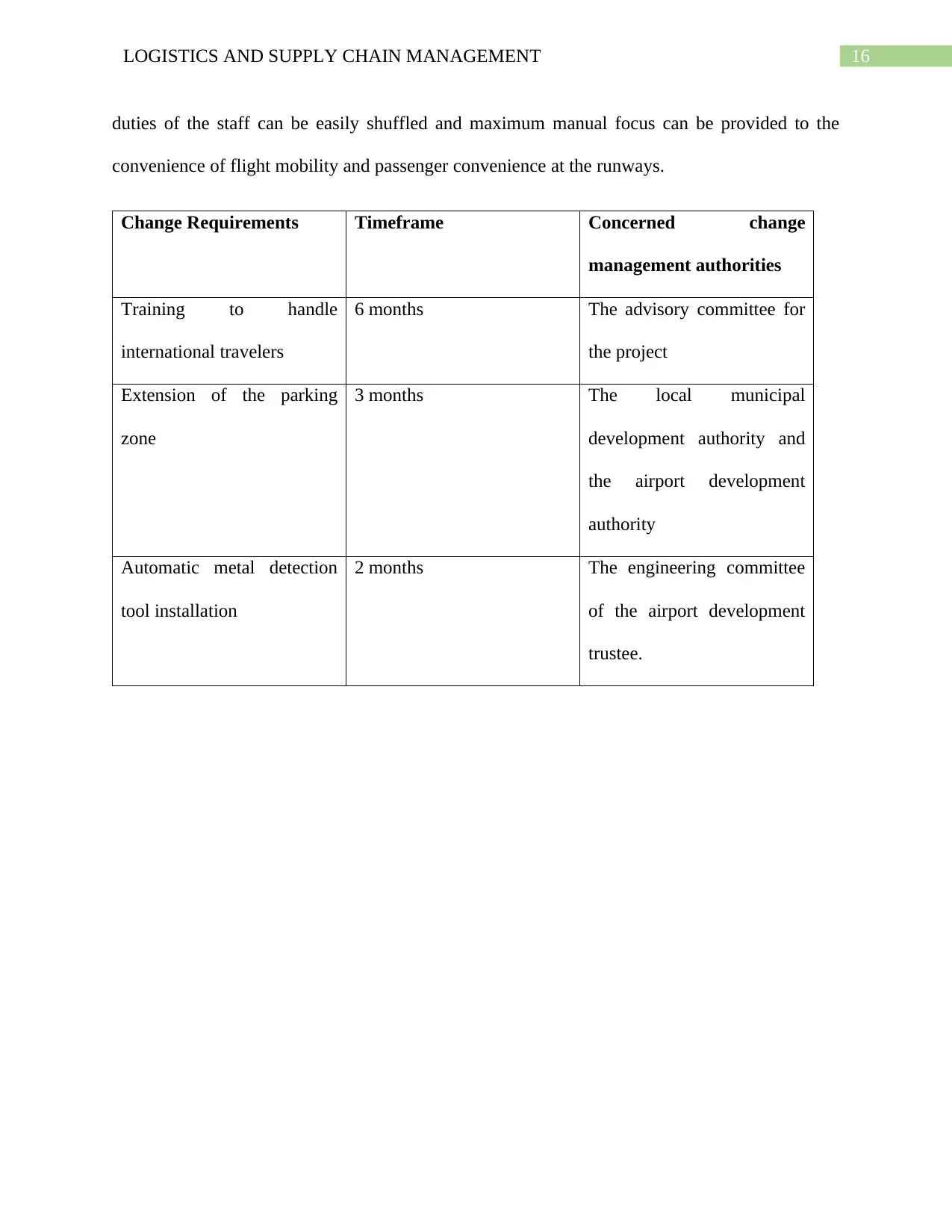
16LOGISTICS AND SUPPLY CHAIN MANAGEMENT
duties of the staff can be easily shuffled and maximum manual focus can be provided to the
convenience of flight mobility and passenger convenience at the runways.
Change Requirements Timeframe Concerned change
management authorities
Training to handle
international travelers
6 months The advisory committee for
the project
Extension of the parking
zone
3 months The local municipal
development authority and
the airport development
authority
Automatic metal detection
tool installation
2 months The engineering committee
of the airport development
trustee.
duties of the staff can be easily shuffled and maximum manual focus can be provided to the
convenience of flight mobility and passenger convenience at the runways.
Change Requirements Timeframe Concerned change
management authorities
Training to handle
international travelers
6 months The advisory committee for
the project
Extension of the parking
zone
3 months The local municipal
development authority and
the airport development
authority
Automatic metal detection
tool installation
2 months The engineering committee
of the airport development
trustee.
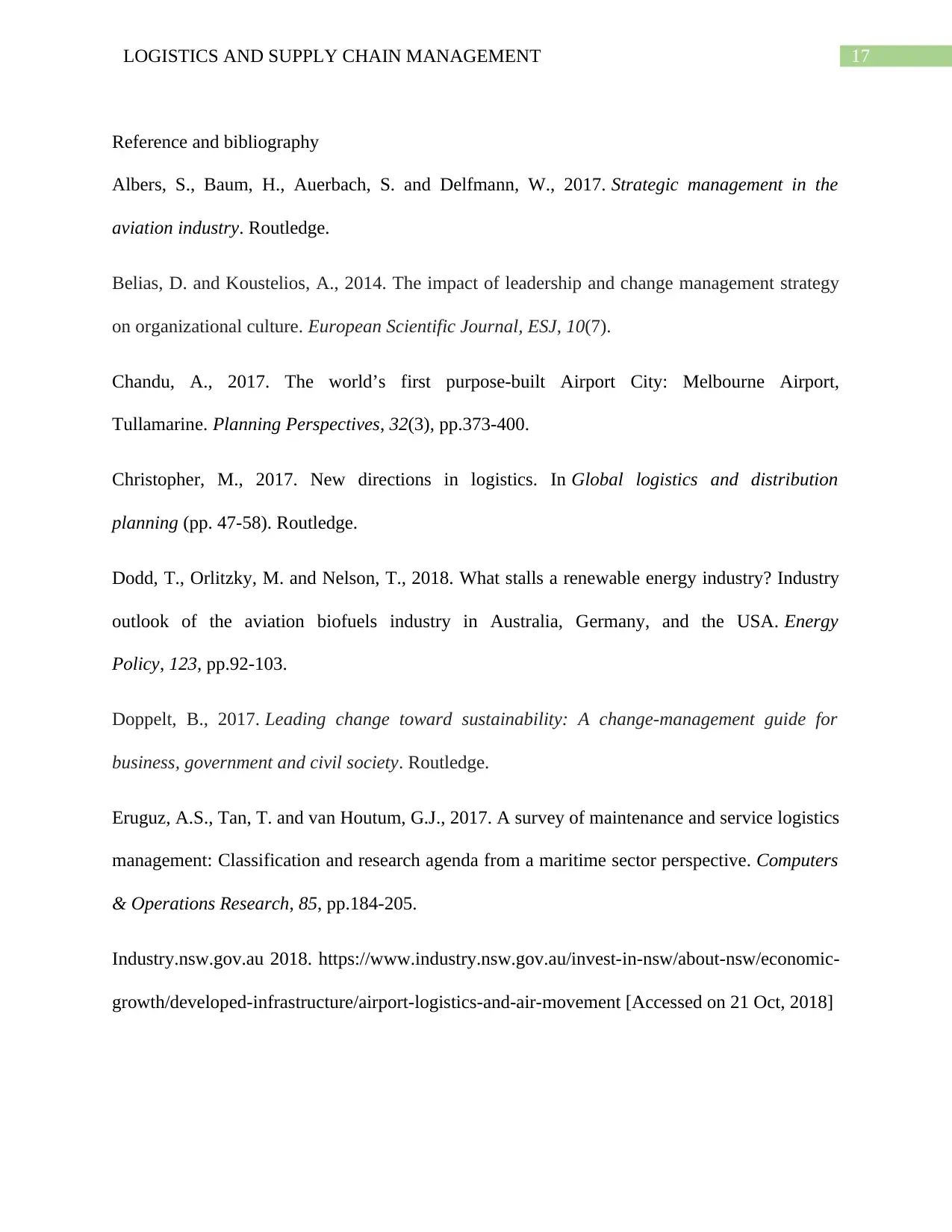
17LOGISTICS AND SUPPLY CHAIN MANAGEMENT
Reference and bibliography
Albers, S., Baum, H., Auerbach, S. and Delfmann, W., 2017. Strategic management in the
aviation industry. Routledge.
Belias, D. and Koustelios, A., 2014. The impact of leadership and change management strategy
on organizational culture. European Scientific Journal, ESJ, 10(7).
Chandu, A., 2017. The world’s first purpose-built Airport City: Melbourne Airport,
Tullamarine. Planning Perspectives, 32(3), pp.373-400.
Christopher, M., 2017. New directions in logistics. In Global logistics and distribution
planning (pp. 47-58). Routledge.
Dodd, T., Orlitzky, M. and Nelson, T., 2018. What stalls a renewable energy industry? Industry
outlook of the aviation biofuels industry in Australia, Germany, and the USA. Energy
Policy, 123, pp.92-103.
Doppelt, B., 2017. Leading change toward sustainability: A change-management guide for
business, government and civil society. Routledge.
Eruguz, A.S., Tan, T. and van Houtum, G.J., 2017. A survey of maintenance and service logistics
management: Classification and research agenda from a maritime sector perspective. Computers
& Operations Research, 85, pp.184-205.
Industry.nsw.gov.au 2018. https://www.industry.nsw.gov.au/invest-in-nsw/about-nsw/economic-
growth/developed-infrastructure/airport-logistics-and-air-movement [Accessed on 21 Oct, 2018]
Reference and bibliography
Albers, S., Baum, H., Auerbach, S. and Delfmann, W., 2017. Strategic management in the
aviation industry. Routledge.
Belias, D. and Koustelios, A., 2014. The impact of leadership and change management strategy
on organizational culture. European Scientific Journal, ESJ, 10(7).
Chandu, A., 2017. The world’s first purpose-built Airport City: Melbourne Airport,
Tullamarine. Planning Perspectives, 32(3), pp.373-400.
Christopher, M., 2017. New directions in logistics. In Global logistics and distribution
planning (pp. 47-58). Routledge.
Dodd, T., Orlitzky, M. and Nelson, T., 2018. What stalls a renewable energy industry? Industry
outlook of the aviation biofuels industry in Australia, Germany, and the USA. Energy
Policy, 123, pp.92-103.
Doppelt, B., 2017. Leading change toward sustainability: A change-management guide for
business, government and civil society. Routledge.
Eruguz, A.S., Tan, T. and van Houtum, G.J., 2017. A survey of maintenance and service logistics
management: Classification and research agenda from a maritime sector perspective. Computers
& Operations Research, 85, pp.184-205.
Industry.nsw.gov.au 2018. https://www.industry.nsw.gov.au/invest-in-nsw/about-nsw/economic-
growth/developed-infrastructure/airport-logistics-and-air-movement [Accessed on 21 Oct, 2018]
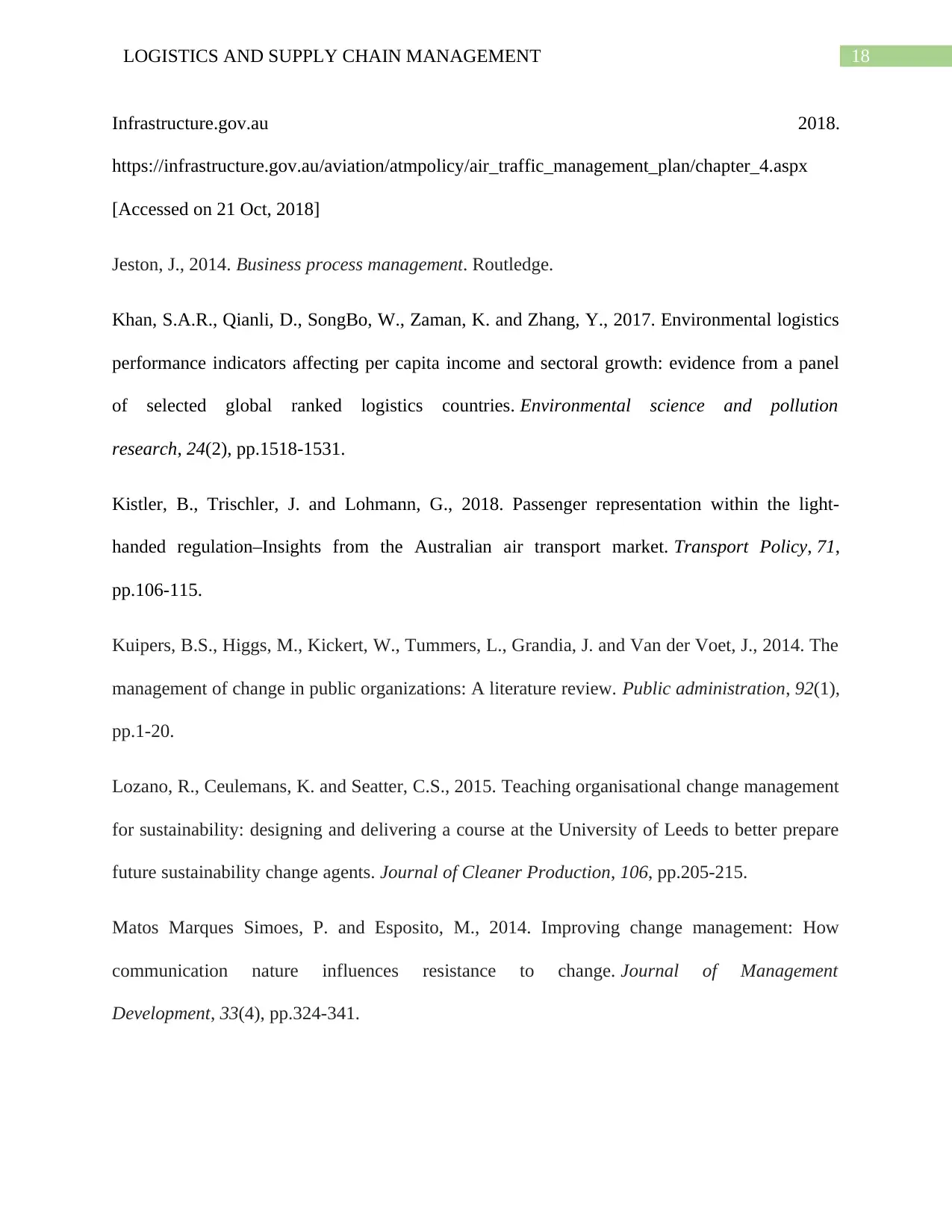
18LOGISTICS AND SUPPLY CHAIN MANAGEMENT
Infrastructure.gov.au 2018.
https://infrastructure.gov.au/aviation/atmpolicy/air_traffic_management_plan/chapter_4.aspx
[Accessed on 21 Oct, 2018]
Jeston, J., 2014. Business process management. Routledge.
Khan, S.A.R., Qianli, D., SongBo, W., Zaman, K. and Zhang, Y., 2017. Environmental logistics
performance indicators affecting per capita income and sectoral growth: evidence from a panel
of selected global ranked logistics countries. Environmental science and pollution
research, 24(2), pp.1518-1531.
Kistler, B., Trischler, J. and Lohmann, G., 2018. Passenger representation within the light-
handed regulation–Insights from the Australian air transport market. Transport Policy, 71,
pp.106-115.
Kuipers, B.S., Higgs, M., Kickert, W., Tummers, L., Grandia, J. and Van der Voet, J., 2014. The
management of change in public organizations: A literature review. Public administration, 92(1),
pp.1-20.
Lozano, R., Ceulemans, K. and Seatter, C.S., 2015. Teaching organisational change management
for sustainability: designing and delivering a course at the University of Leeds to better prepare
future sustainability change agents. Journal of Cleaner Production, 106, pp.205-215.
Matos Marques Simoes, P. and Esposito, M., 2014. Improving change management: How
communication nature influences resistance to change. Journal of Management
Development, 33(4), pp.324-341.
Infrastructure.gov.au 2018.
https://infrastructure.gov.au/aviation/atmpolicy/air_traffic_management_plan/chapter_4.aspx
[Accessed on 21 Oct, 2018]
Jeston, J., 2014. Business process management. Routledge.
Khan, S.A.R., Qianli, D., SongBo, W., Zaman, K. and Zhang, Y., 2017. Environmental logistics
performance indicators affecting per capita income and sectoral growth: evidence from a panel
of selected global ranked logistics countries. Environmental science and pollution
research, 24(2), pp.1518-1531.
Kistler, B., Trischler, J. and Lohmann, G., 2018. Passenger representation within the light-
handed regulation–Insights from the Australian air transport market. Transport Policy, 71,
pp.106-115.
Kuipers, B.S., Higgs, M., Kickert, W., Tummers, L., Grandia, J. and Van der Voet, J., 2014. The
management of change in public organizations: A literature review. Public administration, 92(1),
pp.1-20.
Lozano, R., Ceulemans, K. and Seatter, C.S., 2015. Teaching organisational change management
for sustainability: designing and delivering a course at the University of Leeds to better prepare
future sustainability change agents. Journal of Cleaner Production, 106, pp.205-215.
Matos Marques Simoes, P. and Esposito, M., 2014. Improving change management: How
communication nature influences resistance to change. Journal of Management
Development, 33(4), pp.324-341.
Paraphrase This Document
Need a fresh take? Get an instant paraphrase of this document with our AI Paraphraser

19LOGISTICS AND SUPPLY CHAIN MANAGEMENT
Melis, D.J., Silva, J.M. and Silvestre, M.A., 2017. Characterisation of the anthropometric
features of airline passengers and their impact on fuel usage in the Australian domestic aviation
sector. In 17th Australian International Aerospace Congress: AIAC 2017 (p. 529). Engineers
Australia, Royal Aeronautical Society.
Papadopoulos, T., Gunasekaran, A., Dubey, R. and Balta, M., 2017. Big Data and RFID in
Supply Chain and Logistics Management: A Review of the Literature and Applications for Data
Driven Research. In Supply Chain Management in the Big Data Era (pp. 108-123). IGI Global.
Reefke, H. and Sundaram, D., 2017. Key themes and research opportunities in sustainable supply
chain management–identification and evaluation. Omega, 66, pp.195-211.
Rosemann, M. and vom Brocke, J., 2015. The six core elements of business process
management. In Handbook on business process management 1 (pp. 105-122). Springer, Berlin,
Heidelberg.
Samuel, D., Found, P. and Williams, S.J., 2015. How did the publication of the book The
Machine That Changed The World change management thinking? Exploring 25 years of lean
literature. International Journal of Operations & Production Management, 35(10), pp.1386-
1407.
Stark, J., 2015. Product lifecycle management. In Product Lifecycle Management (Volume
1) (pp. 1-29). Springer, Cham.
Sydney.edu.au 2018. https://sydney.edu.au/courses/units-of-study/2018/itls/itls6400.html
[Accessed on 21 Oct, 2018]
Melis, D.J., Silva, J.M. and Silvestre, M.A., 2017. Characterisation of the anthropometric
features of airline passengers and their impact on fuel usage in the Australian domestic aviation
sector. In 17th Australian International Aerospace Congress: AIAC 2017 (p. 529). Engineers
Australia, Royal Aeronautical Society.
Papadopoulos, T., Gunasekaran, A., Dubey, R. and Balta, M., 2017. Big Data and RFID in
Supply Chain and Logistics Management: A Review of the Literature and Applications for Data
Driven Research. In Supply Chain Management in the Big Data Era (pp. 108-123). IGI Global.
Reefke, H. and Sundaram, D., 2017. Key themes and research opportunities in sustainable supply
chain management–identification and evaluation. Omega, 66, pp.195-211.
Rosemann, M. and vom Brocke, J., 2015. The six core elements of business process
management. In Handbook on business process management 1 (pp. 105-122). Springer, Berlin,
Heidelberg.
Samuel, D., Found, P. and Williams, S.J., 2015. How did the publication of the book The
Machine That Changed The World change management thinking? Exploring 25 years of lean
literature. International Journal of Operations & Production Management, 35(10), pp.1386-
1407.
Stark, J., 2015. Product lifecycle management. In Product Lifecycle Management (Volume
1) (pp. 1-29). Springer, Cham.
Sydney.edu.au 2018. https://sydney.edu.au/courses/units-of-study/2018/itls/itls6400.html
[Accessed on 21 Oct, 2018]

20LOGISTICS AND SUPPLY CHAIN MANAGEMENT
Theriou, N.G., 2015. Strategic Management Process and the Importance of Structured Formality,
Financial and Non-Financial Information. European Research Studies, 18(2), p.3.
Theriou, N.G., 2015. Strategic Management Process and the Importance of Structured Formality,
Financial and Non-Financial Information. European Research Studies, 18(2), p.3.
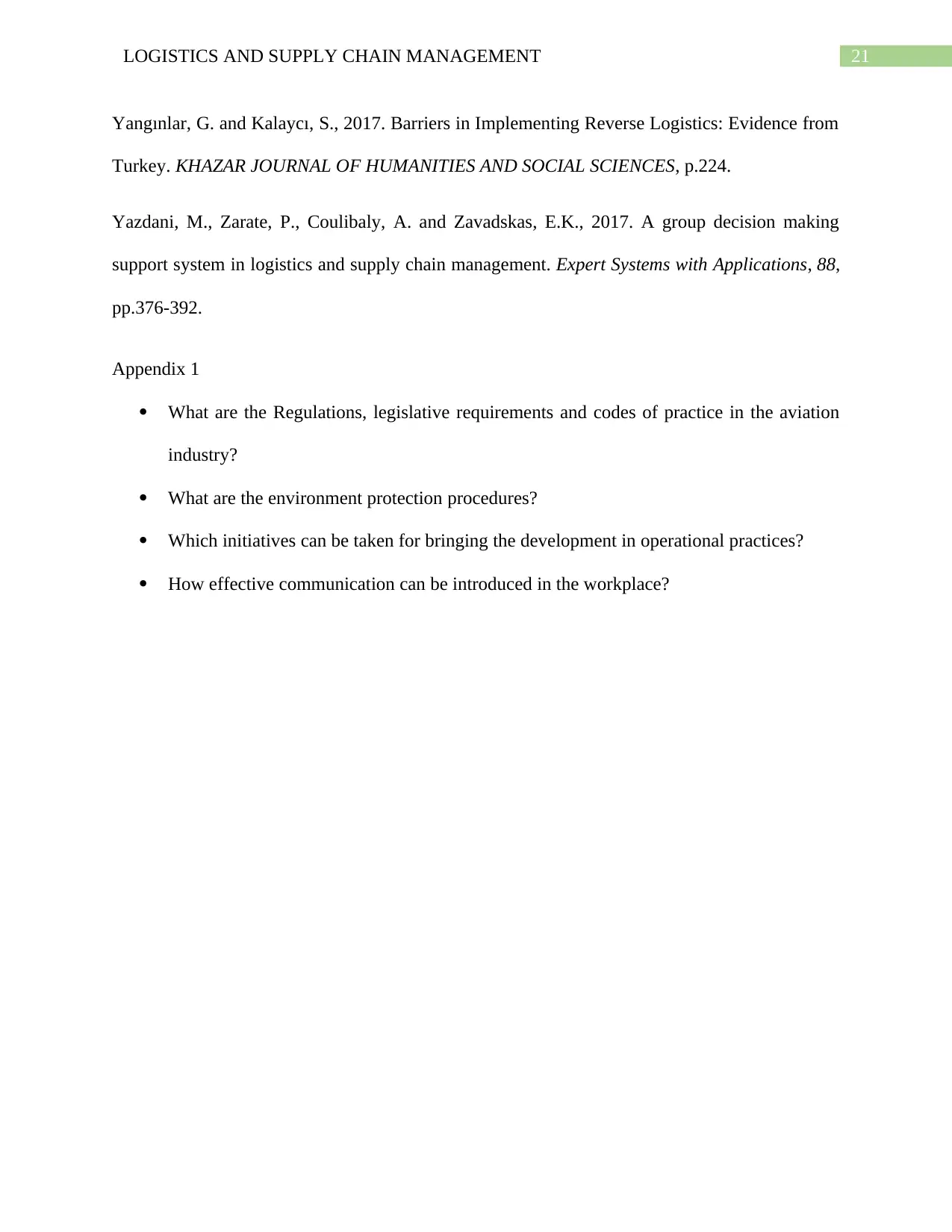
21LOGISTICS AND SUPPLY CHAIN MANAGEMENT
Yangınlar, G. and Kalaycı, S., 2017. Barriers in Implementing Reverse Logistics: Evidence from
Turkey. KHAZAR JOURNAL OF HUMANITIES AND SOCIAL SCIENCES, p.224.
Yazdani, M., Zarate, P., Coulibaly, A. and Zavadskas, E.K., 2017. A group decision making
support system in logistics and supply chain management. Expert Systems with Applications, 88,
pp.376-392.
Appendix 1
What are the Regulations, legislative requirements and codes of practice in the aviation
industry?
What are the environment protection procedures?
Which initiatives can be taken for bringing the development in operational practices?
How effective communication can be introduced in the workplace?
Yangınlar, G. and Kalaycı, S., 2017. Barriers in Implementing Reverse Logistics: Evidence from
Turkey. KHAZAR JOURNAL OF HUMANITIES AND SOCIAL SCIENCES, p.224.
Yazdani, M., Zarate, P., Coulibaly, A. and Zavadskas, E.K., 2017. A group decision making
support system in logistics and supply chain management. Expert Systems with Applications, 88,
pp.376-392.
Appendix 1
What are the Regulations, legislative requirements and codes of practice in the aviation
industry?
What are the environment protection procedures?
Which initiatives can be taken for bringing the development in operational practices?
How effective communication can be introduced in the workplace?
1 out of 22
Related Documents
Your All-in-One AI-Powered Toolkit for Academic Success.
+13062052269
info@desklib.com
Available 24*7 on WhatsApp / Email
![[object Object]](/_next/static/media/star-bottom.7253800d.svg)
Unlock your academic potential
© 2024 | Zucol Services PVT LTD | All rights reserved.




